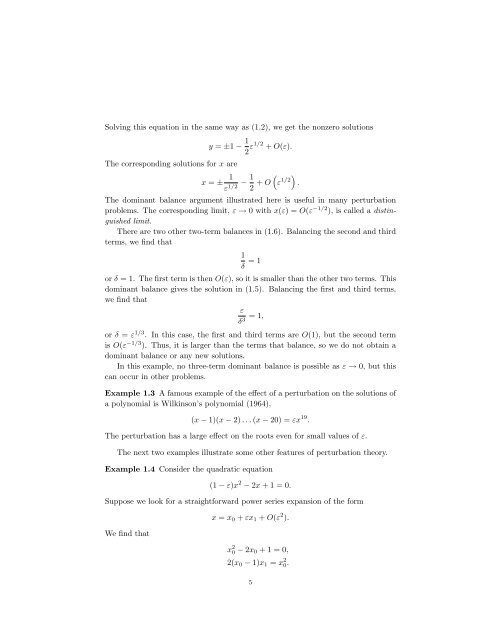Asymptotic Analysis and Singular Perturbation Theory
Asymptotic Analysis and Singular Perturbation Theory
Asymptotic Analysis and Singular Perturbation Theory
You also want an ePaper? Increase the reach of your titles
YUMPU automatically turns print PDFs into web optimized ePapers that Google loves.
Solving this equation in the same way as (1.2), we get the nonzero solutions<br />
y = ±1 − 1<br />
2 ε1/2 + O(ε).<br />
The corresponding solutions for x are<br />
x = ± 1 1<br />
<br />
− + O ε<br />
ε1/2 2 1/2<br />
.<br />
The dominant balance argument illustrated here is useful in many perturbation<br />
problems. The corresponding limit, ε → 0 with x(ε) = O(ε −1/2 ), is called a distinguished<br />
limit.<br />
There are two other two-term balances in (1.6). Balancing the second <strong>and</strong> third<br />
terms, we find that<br />
1<br />
= 1<br />
δ<br />
or δ = 1. The first term is then O(ε), so it is smaller than the other two terms. This<br />
dominant balance gives the solution in (1.5). Balancing the first <strong>and</strong> third terms,<br />
we find that<br />
ε<br />
= 1,<br />
δ3 or δ = ε 1/3 . In this case, the first <strong>and</strong> third terms are O(1), but the second term<br />
is O(ε −1/3 ). Thus, it is larger than the terms that balance, so we do not obtain a<br />
dominant balance or any new solutions.<br />
In this example, no three-term dominant balance is possible as ε → 0, but this<br />
can occur in other problems.<br />
Example 1.3 A famous example of the effect of a perturbation on the solutions of<br />
a polynomial is Wilkinson’s polynomial (1964),<br />
(x − 1)(x − 2) . . . (x − 20) = εx 19 .<br />
The perturbation has a large effect on the roots even for small values of ε.<br />
The next two examples illustrate some other features of perturbation theory.<br />
Example 1.4 Consider the quadratic equation<br />
(1 − ε)x 2 − 2x + 1 = 0.<br />
Suppose we look for a straightforward power series expansion of the form<br />
We find that<br />
x = x0 + εx1 + O(ε 2 ).<br />
x 2 0 − 2x0 + 1 = 0,<br />
2(x0 − 1)x1 = x 2 0.<br />
5
















